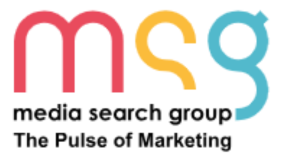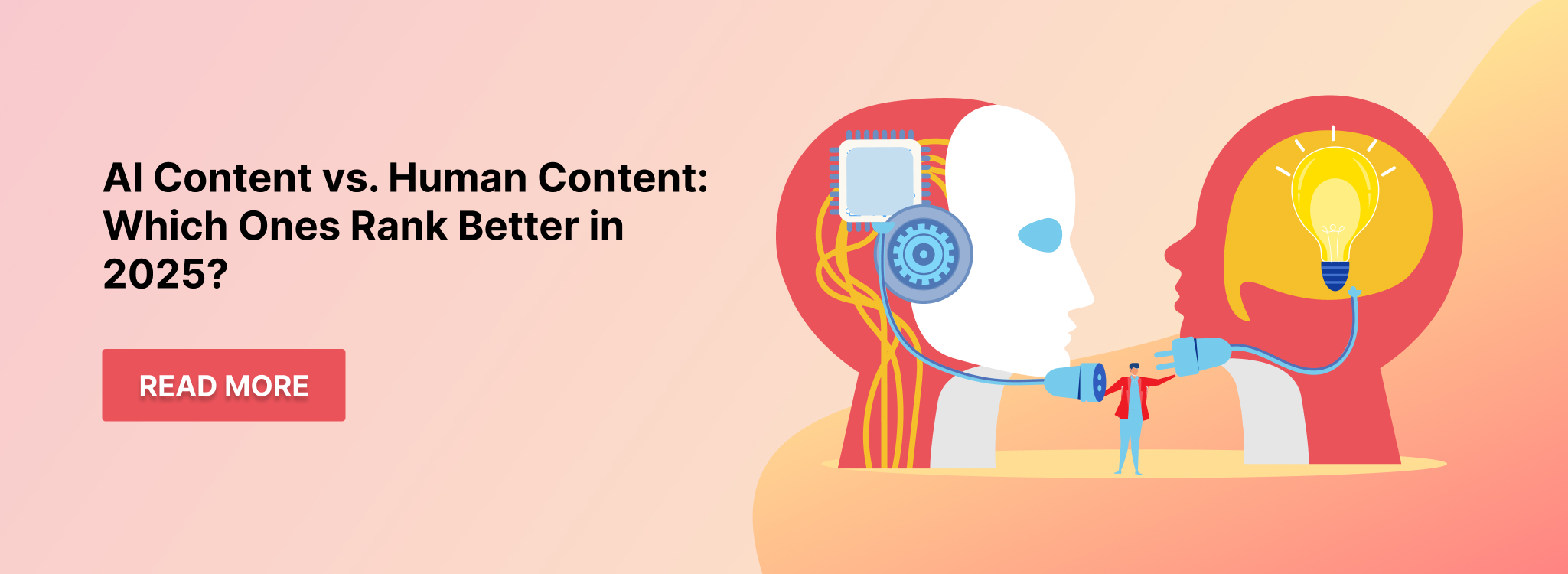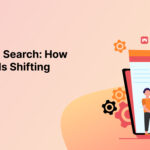AI Content vs. Human Content: Which Ones Rank Better in 2025?
Recently updated: August 6th, 2025
With the rise of tools like ChatGPT, Claude, and Gemini, thousands of businesses have started producing content at scale. But just because it’s fast doesn’t mean it ranks. There’s a lot of noise right now. Some say AI-written articles are dominating the SERPs. Others say Google is penalizing “AI slop” and favoring expert-led content instead.
Both are partly true.
If you’re serious about ranking in Google (and showing up in AI search layers like SGE), you need to know when AI content helps, when it hurts, and why human editing still matters. This isn’t just a trend. It’s a shift in how content is written, optimized, and evaluated.
In this guide, we’ll break down the real performance data behind AI vs human content, show you what Google actually favors, and walk you through how to build a content strategy that wins in 2025.
Google’s 2025 AI Overviews, EEAT & Search Generative Experience
To understand what ranks better – AI content or human-written content – you need to understand what Google is actually showing users in 2025.
And spoiler: it’s not just blue links anymore.
Google’s Search Generative Experience (SGE) is now layered on top of many results, offering users a conversational summary powered by generative AI. Above the fold, before any organic listing shows up, you often see a snapshot, a block of text written by AI, pulling from the most trusted sources it can find. So, the question becomes:
What kind of content gets selected to power these AI Overviews?
Here’s what we know so far.
EEAT Is Still the Filter That Matters Most
In 2025, Google’s ranking systems are even more aligned with EEAT – experience, expertise, authoritativeness, and trustworthiness.
AI-generated content can meet these standards, but not by default.
- Sites that demonstrate real experience (e.g. reviews, tutorials, expert insights) consistently perform better in SGE.
- Pages with clear author information, editorial policies, and references are more likely to be surfaced.
- Thin AI content that looks mass-produced? Often filtered out entirely.
Google isn’t penalizing AI content just because it’s AI, but it is rewarding content that adds real value, regardless of how it was written.
SGE Prioritizes Sources That Summarize Well and Cite Clearly
SGE pulls from web content it trusts. That means your page must be:
- Crawlable and indexable
- Structured clearly (using headers, lists, semantic HTML)
- Supported by schema markup
AI content that’s vague or repetitive rarely gets selected. But a well-structured blog post, whether AI-assisted or human-written with scannable takeaways and citations? That’s prime selection criteria for SGE answers.
The New SEO: Optimizing for AI Readers
![]() You’re no longer just writing for people. In 2025, you’re also writing for:
You’re no longer just writing for people. In 2025, you’re also writing for:
- Google’s SGE algorithms
- AI assistants like Bard and ChatGPT
- Answer engines crawling and summarizing your site
So, while keywords and backlinks still matter, so do:
- Structured data
- Paragraph clarity
- Prompt-matching intent (i.e., writing how people ask questions)
If your content doesn’t answer a question clearly, it likely won’t be chosen to power an AI answer.
Bottom line: Whether written by AI or by hand, your content needs to be structured for AI readability and supported by EEAT signals. That’s what ranks.
Can AI‑Generated Content Rank? Data from Major SEO Studies
The short answer? Yes, AI-generated content can rank. But it depends entirely on how it’s created and where it’s published.
Several independent studies in 2024 and early 2025 analyzed the performance of AI-written pages across Google SERPs, including side-by-side tests of AI vs human content on similar topics.
Here’s what they found.
AI Content Can Reach Page One – But Rarely the Top Three
According to a multi-domain SEO experiment by Reboot Online:
- Pages written entirely by AI (with no human edits) made it to Google’s top 10 in 28% of test cases.
- But only 6% reached the top 3.
That gap matters. Google isn’t blocking AI content from ranking, but it’s clearly still favoring depth, originality, and expertise – areas where human involvement tends to show.
Hybrid Content Outperforms Pure AI at Scale
A 2025 analysis by Writesonic looked at over 500 AI-assisted articles across multiple niches. The highest-performing pages had:
- AI-generated first drafts
- Human revisions for structure, tone, and value
- Manual optimization (headers, CTAs, internal links)
These hybrid pieces ranked 34% higher on average than unedited AI content. And bounce rates were lower too, indicating better user engagement.
Purely AI Content Is Easier to Detect and Dismiss
Here’s the catch: when you publish content that’s clearly AI-generated (generic tone, repetitive phrasing, no new insights), Google tends to deprioritize it. As one SEO agency put it, “It’s not about how the content is made. It’s about how it reads and whether it deserves to rank.”
In other words, if your AI article sounds like a slightly reworded Wikipedia entry, don’t expect it to land in featured snippets or SGE.
So yes, AI content can rank but only when it’s treated like a first draft, not a final product. When paired with human judgment, optimization, and originality, it performs surprisingly well. On its own? It rarely dominates.
Human Written Content: Engagement, Trust & EEAT Advantages
AI might win on speed. But when it comes to trust, relevance, and engagement, human content still has the edge. In 2025, Google isn’t just looking for factual accuracy. It’s scanning for signals of real-world experience. And that’s where human-written (or at least human-led) content consistently pulls ahead.
Here’s why.
Users Trust Content That Feels Personal, Not Programmed
Recent user behavior studies show that audiences are 2.5x more likely to engage with content that:
- Tells a story
- Shows personal experience or opinion
- Cites real examples or case studies
AI-generated text often lacks nuance. It’s grammatically correct, but emotionally flat. Readers can tell and when they sense a generic tone, trust drops. Whether it’s a blog post, review, or landing page, users are more likely to stay, scroll, and convert when they feel a human is behind the words.
EEAT Favors Authorship, Identity & Authority
Google’s own Search Quality Rater Guidelines have made it clear: authorship matters.
Human-written content typically includes:
- A named author (with credentials or bio)
- Source links and references
- A clear voice and point of view
All of these signal “realness” to both readers and search engines. AI content, especially when published anonymously, can miss these marks entirely. It might check technical SEO boxes, but it falls short on authenticity, which impacts rankings under EEAT.
Better Engagement = Better Rankings
![]() When you publish human-first content that resonates, here’s what usually happens:
When you publish human-first content that resonates, here’s what usually happens:
- Time on page increases
- Bounce rate drops
- Internal clicks go up
These behavioral signals tell Google: “This content is useful.” And when combined with EEAT and relevance, it leads to stronger rankings.
You don’t need every article to be a 2,000-word personal essay. But when you inject human insight into your SEO strategy, even if it’s just editing AI drafts, you send stronger signals to both your audience and the algorithm. That’s what gives human content its staying power.
Pitfalls of Pure AI Content: Spam, “AI Slop” & Scaled Abuse
The rise of AI tools has made content creation faster. But it’s also created a new kind of problem – content spamming. We’re talking about low-effort, high-volume articles that flood the internet without offering anything new.
Google has a name for this kind of content: scaled abuse. And when it sees it, it steps in.
What Is “AI Slop,” and Why Does Google Care?
“AI slop” is the term used by SEOs and engineers to describe auto-generated content that looks like filler.
It often includes:
- Repetitive phrasing
- Generic advice with no unique angle
- Overuse of keywords without semantic variation
- No author attribution or credibility markers
In short: it reads like something no human would ever bookmark, share, or reference. And in 2025, Google’s systems are much better at detecting it.
Scaled AI Content = Scaled Risk
Sites that publish hundreds (or thousands) of AI-written pages without human oversight are now being flagged under Google’s site reputation abuse and spammy automated content policies.
In some cases:
- Entire sections are de-indexed
- Rankings drop sitewide
- Manual actions are issued (especially for affiliate-heavy AI blogs)
Google isn’t banning AI, but it is cracking down on how it’s used.
You Can’t “Mass Produce” Authority
Here’s the hard truth: no matter how many blog posts you generate with AI, they won’t rank if they don’t provide value. This is especially true for:
- YMYL (Your Money, Your Life) niches
- Health, finance, legal, and educational content
- Reviews, recommendations, or product roundups
If Google suspects your content was created just to manipulate rankings, it won’t give you visibility, no matter how grammatically clean it looks.
Using AI for scale isn’t bad. But using it without strategy is what lands you in trouble. If your content isn’t edited, checked, enriched, and optimized, it’s not just low-quality; it’s a liability.
Hybrid Models: Combining AI Speed with Human Oversight
If you want to scale without sacrificing quality, this is the model to watch. In 2025, the most successful content strategies aren’t fully human or fully AI, they’re hybrid.
That means using AI to speed up the process… and humans to shape the output into something worth reading (and worth ranking). Here’s how the best-performing teams are doing it:
Start with AI to Draft, Research, or Outline
AI tools like ChatGPT, Claude, and Gemini are excellent at:
- Generating content briefs
- Drafting first-pass introductions and conclusions
- Summarizing research or public data
- Creating outlines that follow SEO intent
This cuts time in half and helps content teams work faster without starting from a blank page. But that’s just the beginning.
Human Editing Is Where the Quality Happens
After the AI draft is done, here’s where humans step in:
- Restructuring content for clarity and tone
- Adding expert insights or unique POVs
- Injecting personal anecdotes or real examples
- Polishing phrasing for voice and rhythm
- Optimizing headers, CTAs, and metadata
This phase is where most of the EEAT value gets built in.
Review for AI “Tells” Before Publishing
Even with good prompts, AI can still fall into predictable habits. That’s why you need a human eye to check for:
- Repetitive sentence structures
- Overuse of hedging phrases (“may help,” “could be useful”)
- Hallucinated facts or missing citations
- Keyword stuffing or unnatural phrasing
These are the red flags that both Google and readers pick up on. Editing them out is what separates high-quality hybrid content from spammy AI filler.
The Hybrid Advantage
This model offers the best of both worlds:
- Speed of AI
- Trustworthiness of human authorship
- Scalability without compromising quality
It’s how editorial teams are producing more content without burning out or getting penalized and how smart businesses are future-proofing their SEO in the AI era.
The “ChatGPT Angle”: How to Leverage AI Tools in 2025 SEO
Not all AI is created equal and not all content tools are built for ranking. If you’re using ChatGPT or similar AI writers to support your SEO, you need to know how to get the most out of them without triggering Google’s red flags.
Here’s what works (and what doesn’t) when using ChatGPT in your content workflow:
Use Prompts That Mimic Real Search Queries
Instead of asking ChatGPT for “a blog post about time management,” try prompting it like this:
“Write a blog outline that answers the query: ‘How to manage time effectively as a remote worker in 2025?’”
This aligns the structure with how people search and how Google understands intent. The best ChatGPT content starts with the right prompt. Ask it to write for search intent, not just fill space.
Avoid Generic Language: Train for Specificity
![]() ChatGPT loves safe, general phrasing.
ChatGPT loves safe, general phrasing.
But SEO content in 2025 demands specificity.
When reviewing AI drafts, check for:
- Vague adjectives (“great,” “useful,” “important”)
- Redundant phrases (“in today’s fast-paced world”)
- Empty filler lines (“content is king”)
Replace them with:
- Specific use cases
- Stats or real-world examples
- Clear, actionable language
This is what makes your content sound like you, not like a robot trying to imitate you.
Pair ChatGPT with Schema and Internal Linking
ChatGPT can generate text but it won’t automatically:
- Add product or FAQ schema
- Link to your cornerstone pages
- Optimize headers for featured snippets
That’s your job (or your SEO’s). Think of ChatGPT as a writing assistant, not a strategist. It writes well, but it doesn’t know your content architecture or your KPIs.
Don’t Let ChatGPT Publish Unchecked
This might sound obvious, but it needs to be said: Never hit publish on raw AI output.
Review it. Restructure it. Run it through fact-checking tools. Then shape it into something that reflects your brand and meets Google’s expectations. If you use ChatGPT well, it becomes a powerful ally. If you use it lazily, it becomes a ranking liability.
Reader Preference & Bias: Human vs AI Awareness
What about the people reading your content? Can they tell the difference and does it even matter?
Turns out, it does. Recent behavioral studies in 2025 have uncovered a surprising (but important) pattern: readers often prefer AI-written content… until they know it’s AI-written.
Here’s what that means for your SEO and content strategy:
People Judge Quality First Then Source
In a blind test conducted by Brandwell.ai, readers were given two versions of the same article:
- One written by a human
- One generated by AI using GPT-4o
Most participants rated the AI version higher on clarity and flow.
But when they were told which was which?
- 63% changed their preference to the human article
- 72% said they would trust the human-written version more for “important decisions” (like finances or health)
In short: perception matters.
Disclosure Impacts Trust, Especially in YMYL Content
![]() In niches like:
In niches like:
- Finance
- Healthcare
- Legal
- Education
…users want to know who wrote the content—and why they should trust it.
Even if AI generates the bulk of the article, failing to provide:
- Author bios
- Editorial disclaimers
- Links to source material
…can lower trust and engagement.
Readers may not mind AI helping, but they want humans checking.
AI Detection Tools Shape Reader Expectations
With the rise of tools like GPTZero and Originality.ai, readers (and editors) are becoming more skeptical of robotic content. Some publications now display “AI-assisted” labels. Others require human oversight by policy. In either case, users expect transparency and are more likely to bounce if they feel “tricked” by auto-generated fluff.
So, should you stop using AI? Not at all. But blending AI’s speed with human insight and being transparent about it builds long-term trust. And trust still ranks.
Practical SEO Guide: Content Strategy in 2025
Let’s get tactical. If you’re building a content plan this year, here’s how to align it with what actually ranks, whether you’re writing with AI, without it, or somewhere in between.
These aren’t just tips. This is your 2025 SEO playbook.
Start with Real Search Intent
Don’t just target keywords. Target questions. Use tools like AlsoAsked, Google’s “People Also Ask,” or even ChatGPT itself to surface what people actually want to know.
Structure every article to answer those prompts in full, like:
- “What are the best credit cards for freelancers in 2025?”
- “How to treat anxiety without medication?”
- “Best time tracking apps for remote teams?”
These are real queries with buying, clicking, or reading intent. Match them.
Use AI for Drafting, But Never for Finishing
AI is a great brainstorming tool. It’s also decent at first-pass writing. But your process should always look like this:
- Use AI to build structure or generate the draft
- Inject human expertise, quotes, or unique POV
- Edit heavily for tone, clarity, and value
- Optimize for search, EEAT, and readability
AI is a fast car. You’re still the one driving.
Inject EEAT Signals Everywhere
Google is watching for expertise and trust. You can prove it by:
- Adding author bios with credentials
- Linking to trusted sources and citations
- Including first-hand insights or case studies
- Avoiding vague, surface-level commentary
If it reads like it was written by someone who knows the topic? That’s a ranking signal now.
Optimize for AI Summarization & Indexing
Search in 2025 includes AI snapshots and summaries. To show up, your content needs to be:
- Well-structured with clear headings
- Formatted with bullet points and short paragraphs
- Supported by schema (Article, FAQ, Product, etc.)
- Written in natural, answer-like phrasing
If your article sounds like something an AI could quote or summarize… you’re doing it right.
Use UTM Tracking to Measure AI Impact
Want to know if ChatGPT, Bard, or other AI tools are driving traffic?
Check your analytics for links tagged with:
- ini
- CopyEdit
- utm_source=chatgpt.com
- utm_medium=referral
You can even create custom segments in GA4 or Looker Studio to track how AI-referred visitors behave vs traditional searchers. This helps you double down on what works and cut what doesn’t.
You don’t need hundreds of articles. You need the right ones built for today’s AI-influenced search experience.
Verdict: Which Ranks Better in 2025?
So, after all the data, case studies, and algorithm updates… who wins? The answer isn’t as black and white as “AI vs human.” Here’s how it really breaks down in 2025.
AI Content Wins on Speed, Scale, and Cost
 It’s fast.
It’s fast.- It’s consistent.
- It allows teams to publish more with fewer resources.
When guided by strong prompts and reviewed carefully, AI content can support content marketing efforts at scale.
It’s especially useful for:
- Drafting FAQs, metadata, outlines
- Covering long-tail, low-competition topics
- Supporting SEO refreshes of older posts
But on its own? It rarely ranks in the top 3, especially for competitive or high-trust queries.
Human Content Wins on Depth, Trust, and Engagement
When ranking depends on EEAT, user engagement, and nuanced relevance (which it often does), human-written or heavily-edited content consistently performs better.
Humans win in areas like:
- Thought leadership
- Product reviews and case studies
- Health, legal, and financial content
- Editorial content with brand voice and personality
These pages aren’t just optimized; they feel intentional. And that’s something AI still can’t replicate on its own.
The Real Winner: Hybrid Content with Human Oversight
The best-performing content in 2025 is usually created using both:
- AI for speed, outline, or research
- Humans for insight, editing, and EEAT compliance
This blend creates scalable, readable, and rankable content without the penalties of spam or the bottlenecks of traditional editorial teams. If you want to future-proof your rankings, don’t pick sides. Pick strategy.
Future Outlook: SEO Beyond 2025
We’re not just watching a shift; we’re watching a convergence. Search, AI, and content are becoming inseparable. And what works today is already being reshaped by what’s coming next.
Here’s what’s on the horizon and what you should prepare for if you want your content to keep ranking in the years ahead:
AI Overviews Are Just the Beginning
Google’s SGE is the start of a broader trend: generative layers on top of search.
Expect:
- More conversational summaries at the top of results
- Fewer visible blue links
- More integration with personal context (location, history, device behavior)
That means your content won’t just compete for rankings; it’ll compete to be quoted or summarized by AI. If your article doesn’t read like an answer, it won’t be selected as one.
Voice + Agent-Based Search Will Reshape Queries
![]() With AI agents, voice tools, and smart assistants evolving fast, queries are getting longer, more specific, and more conversational.
With AI agents, voice tools, and smart assistants evolving fast, queries are getting longer, more specific, and more conversational.
We’re moving toward questions like:
- “Can you find me a beginner-friendly stock trading guide by a certified expert?”
- “Read me the key takeaways from a reliable article on intermittent fasting.”
Your content will need to:
- Match natural speech patterns
- Be structured for easy summarization
- Include clear author signals and trust indicators
This is where schema, headings, and helpful formatting pay off.
AI Feeds and Content Submissions Will Expand
Just like Google has Merchant Center, OpenAI and other platforms are exploring ways for publishers to submit structured content directly.
Expect new submission methods, feeds, and indexing tools that prioritize:
- Freshness
- Credibility
- Semantic relevance
The earlier you build your site to support this through schema, tagging, and structured URLs, the more discoverable you’ll be.
Your Edge? Still Human Judgment
As AI gets smarter, your advantage won’t be more automation, it’ll be better decision-making.
The brands that win are already:
- Auditing what content to create and why
- Using AI to accelerate, not replace
- Publishing with purpose, not volume
That’s the kind of strategy that survives algorithm shifts, SGE layers, and whatever’s next.
Conclusion & Takeaway
The debate between AI content and human content isn’t going away anytime soon. But in 2025, the verdict is clear:
It’s not about who writes the content, it’s about how it’s written, structured, and optimized. AI can help you scale. Humans can help you resonate. The best strategies combine both. If you’re still publishing content like it’s 2015, churning out keyword-stuffed blogs without structure, voice, or trust, you’ll get left behind. Not just by Google, but by users and AI engines too.
But if you treat AI like a tool, not a replacement, you’ll gain an edge. Use it to move faster. Use it to ideate smarter. Then layer on what only humans can bring: experience, judgment, and depth.
This is the new SEO. One where:
- Content is written for both search and AI
- Structure matters as much as substance
- Speed means nothing without strategy
Whether you’re running a content team, publishing solo, or optimizing client sites, one thing’s clear: The brands that blend AI with human insight will own the rankings, not just in 2025, but long after.
Frequently Asked Questions
-
Can AI-generated content rank in Google in 2025?
Yes. Google does not automatically penalize AI-written content. However, it evaluates quality, relevance, and EEAT (Experience, Expertise, Authoritativeness, Trust). AI content that meets these standards, especially when edited by humans, can and does rank.
-
Does Google prefer human-written content over AI?
Google prefers helpful content. Whether it’s written by a person or an AI, what matters is whether the content meets user intent, demonstrates experience, and provides value. In high-trust niches, human-written or heavily-edited content typically performs better.
-
What is “AI slop,” and how does it affect rankings?
“AI slop” refers to low-effort, mass-produced AI content that offers little value. This kind of content is often repetitive, generic, and shallow – qualities that trigger Google’s spam detection systems. Sites publishing large volumes of AI slop risk de-indexing or ranking drops.
-
Is hybrid content better than fully AI or fully human content?
Yes. In most SEO case studies from 2024–2025, hybrid content, AI-assisted drafts with human oversight and editing, consistently ranks higher than raw AI or unoptimized human content. It’s the most scalable and effective strategy for modern content teams.
-
How do I track AI-generated traffic to my site?
Use UTM parameters to track referrals. For ChatGPT, for example, look for: utm_source=chatgpt.com
Set up tracking in Google Analytics or other platforms to see which AI tools are driving visits to your site.
-
Will AI-generated content be featured in Google’s SGE (AI Overviews)?
Only if it meets quality standards, Google SGE favors content that’s well-structured, credible, and written with clear intent. Whether AI-assisted or not, your content needs to be optimized for summarization and trust.
-
Should I disclose that I’m using AI to write content?
Transparency is increasingly important, especially in regulated industries. You don’t need to flag every sentence, but adding author bylines, editorial oversight, and citations can reinforce trust, even if AI helped in the drafting phase.
-
Can small businesses benefit from AI-generated content?
Absolutely. AI helps small teams scale their output efficiently. Just make sure it’s paired with human insight and SEO best practices because quality, not quantity, drives rankings.
Latest posts by Vijaya Tyagi (see all)
AI Mentions Are the New Backlinks – Why They Matter - December 10, 2025
Local AI SEO: Get Picked for “Near Me” - November 26, 2025









